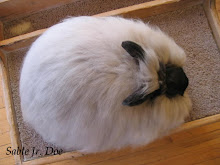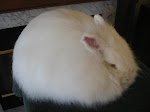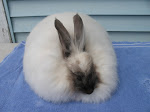Note: This is another post from the old blog, but if I were writing it now I would probably change the Sr. peak date from 9 months to 10 or 11. A 4 month old coat would certainly be primed and would probably be impressive on the showtable, but a 5 /6 month coat (as long as it was prime and not slipping) would be more competitive still.
There are several charts available to help breeders time breedings for particular shows or maturation points at certain times during the year. Since hold times and molting cycles have changed for the typical French Angora over the last 20 years or so, a modern chart would need to include current development rates and assume that individual coats are being held and released later.
If we assume that today's FA Junior peaks at approx. 4--4 1/2 months (in some lines), we need to devise a list in order to plan our breedings so that babies are hitting the most important shows by exactly 4 months. Here is a list of the 12 months of the year alongside a column listing what month a rabbit would reach peak Junior age ( 4 months/ 16 weeks old) if bred by the month in the first column:
Breed In (for) 4 Month Old Juniors in:
January /June
February /July
March/ August
April/ September
May/ October
June/ November
July/ December
August/ January
September/ February
October/ March
November/ April
December/ May
Also, if we assume that an FA molts it's first coat and is harvested at 5 months, it will probably not peak again as a Senior until approx. 9 months of age (though if hold time is different, breeding dates will need to be adjusted accordingly). Assuming that you are trying to breed a 9 month old Senior for a specific show, here are the months you would need to breed in, in order to achieve that.
Breed In (for) 9 months old in:
January/ November
February/ December
March/ January
April/ February
May /March
June/ April
July/ May
August/ June
September/ July
October/ August
November/ September
December/ October
These are examples based on dates targeting 4 month old Juniors and 9 month old Seniors. The key thing to take note of is precisely what age your rabbits tend to peak in either category. Take notes on the development of your herd, and plan your breedings accordingly. Generally it is a good idea to push coats to be as large and heavy as they can be before they actually begin to slip (the very end of the Prime phase), and plan your Juniors to be as large as possible with as much wool growth acumulated before they actually go overweight (keeping them at or just under 7 1/2 lbs.).
Again, as many of us know, raising Angoras for show all boils down to timing, timing, timing:). Showbreeders are not the only ones who benefit from manipulating a molt either. Managers of fiber herds may time breedings also so that bunnies are bald in the summertime when temps, are highest, and in full coat during the winter when temperatures plunge. The nature of an Angora growth cycle is such that a breeder CAN time breedings to manipulate a coat for his/her own needs--- just one more advantage to owning these wonderful rabbits for wool or show.
Sunday, December 14, 2008
Subscribe to:
Post Comments (Atom)























2 comments:
Hello Amy. Please continue posting on your blog. I really like seeing all your new posts. I know you must be quite busy, but your expertise is so graciously received by all of us who visit your blog often to learn from you. I've noticed you have not posted since the 14th, please post more topics.
Thanks for all you do to help us all!
Mary J
Amy,
I cannot seem to access your email address and I would like to get in contact with you. If you would please email me back about rabbits that you have for sale that would be much appreciated.
Kind regards and seasons greetings, Lucas Fletcher
Lucas.Fletcher@gmail.com
Post a Comment